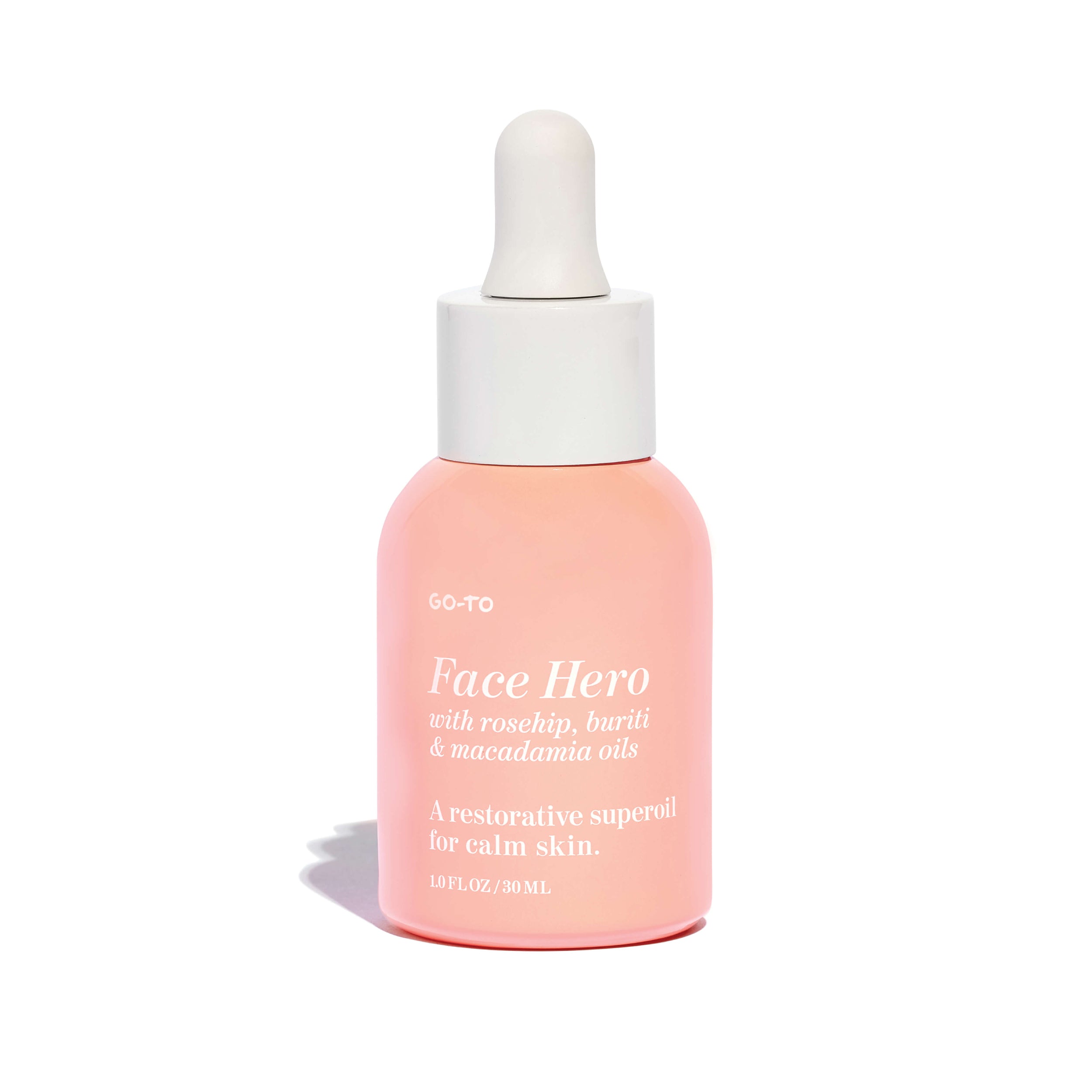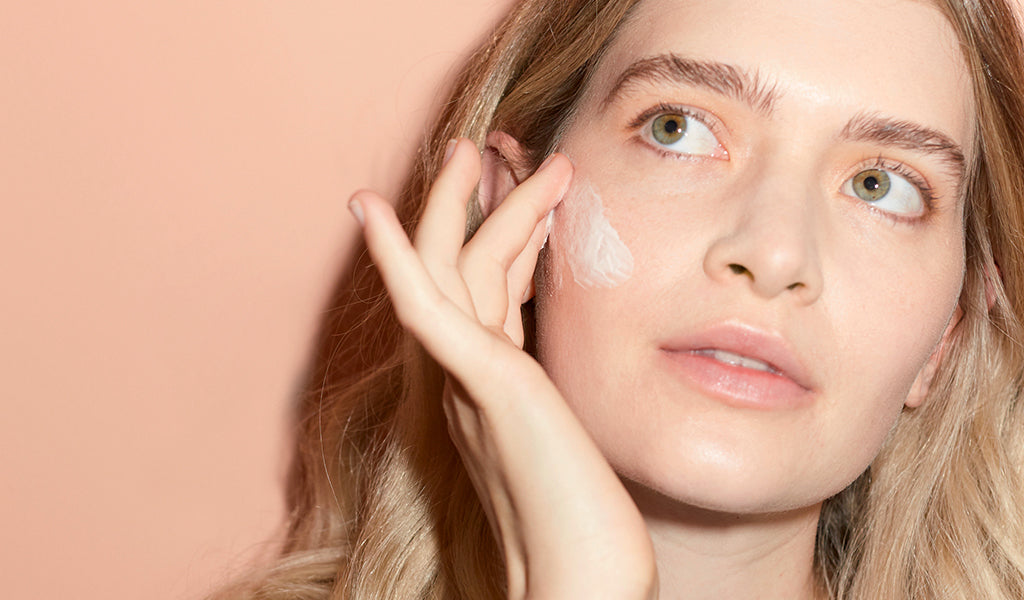We know you have lots of questions about how to use Go-To with your favourite serums and to refine your routine. And we want to give you the tools to have these very good questions answered. (We’re adorable/generous like that.) So we called on skin expert/dermal therapist, Yads Cauchi to answer all of those very important questions right here.
Niacinamide. What can it be used with and what can’t it be used with? That is the question.
Niacinamide can honestly be used with almost everything and anything. It’s a brilliant all-rounder serum tolerated by most skin types. Some people suggest it’s best to not use vitamin c and niacinamide together, however, recent research has shown this to not be accurate.
I personally use a niacinamide serum on top of a vitamin c in the morning, but some products combine the two ingredients as well. Niacinamide works to buffer the effects of retinols too, so if you use them both at night, it should be fine. And although you can use niacinamide and hydroxy acids together if you can help it, I’d try to avoid. You see, niacinamide tends to work best in a neutral pH environment, while hydroxy acids tend to have an extremely low pH level. Which means when combined it produces nicotinic acid, which can potentially lead to irritation, or skin flushing. While it’s not the end of the world and won’t do too much harm, the two ingredients basically cancel each other out. So if you want to use niacinamide at night I’d opt for use on nights you don’t use a hydroxy acid, or use in the AM instead.
What are the best serums/product types for skin post 40?
If your barrier is not impaired/sensitised get yourself a vitamin a (retinoid) serum for PM use. Retinoids are essentially a group of compounds derived from vitamin a and are the only ingredients to repeatedly show anti-ageing benefits in scientific studies. They’re the gold standard in skin care when it comes to ageing and can help to minimise the appearance of wrinkles, fade pigmentation, stimulate cell renewal, and collagen production. They’re amazing. Get them on your face.
However, retinoids can be broken down into two different groups: prescription strength and non-prescription strength. Prescription strength retinoids generally include ingredients such as: tretinoin, isotretinoin, and tazarotene. While over the counter retinoid ingredients tend to refer to: retinol, retinaldehyde, retinol esters, and adapalene. The main difference between the two is that prescription strength retinols are already retinoic acids while non-prescription versions need to be converted into retinoic acid by the skin. You see, it’s only when retinols have been converted into retinoic acid by the skin that you’re likely to see any clinical benefit.
P.S. Start slowly. Retinols are PM based serums. Use every two/three nights and gradually work your way up.
How can I control sebaceous filaments on my face?
Controlling the amount of oil on the skin by exfoliating regularly is key to controlling sebaceous filaments on your face. Even just using a salicylic acid face wash can do wonders. Salicylic acid is a BHA that works by getting into the pores to clear out dirt/junk that gets built up over time. It’s often an ingredient used to treat acne, although when sebaceous filaments are a concern it can help to prevent more while additionally reducing ones you already have.
Properly Clean has white willow bark extract which is a natural form of salicylic acid and La Roche Posay have just released a new one called Effaclar Gel Purifiant Micropeeling that can be used on the body as well.
Is rosacea something that can be fixed or only managed? And if management is the only solution, what’s the one product you’d recommend?
Unfortunately, rosacea is a chronic disease and there is no cure. Sadly that means that it can’t be fixed but it can be kept under control. People with rosacea tend to go through cycles with it. Sometimes it flares up and at other times it can be totally fine. Some triggers for rosacea are: sun exposure, emotional stress/change, temperature extremes, alcohol, spicy food, hot drinks, pretty much all the fun things in life. When you have rosacea it pays to be mindful about these.
My number one product for rosacea would have to be a good daily broad spectrum with SPF30+ because sun exposure can drive the condition. Physical (zinc oxide or titanium dioxide based) SPFs might be better tolerated than chemical. To manage inflammatory bumps, flare ups, and improve skin sensitivity, keep an eye out for serums/gels with azelaic acid as these can be very helpful as well. Also: in-clinic treatments like LED light therapy or genesis laser are ahhh-mazing too!
What's best for congested skin? Not irritated, not pimples, not blackheads. They just look like small bumps. I worry that my skin doesn't absorb my lovely Go-To products because of this.
When it comes to treating congested skin proper cleansing and exfoliating is key! I’m sure you’re always double cleansing at night (Fancy Face first, then Properly Clean would be perfect). Something else to think about is how often you’re exfoliating; upping the ante might be a good idea. (No more than three times a week, though.) Using products with hydroxy acids, like salicylic acid especially will help clear your skin. Retinol also helps with cell turnover in the skin (which will reduce your skin’s ability to congest) and it can also reduce oil production which is also very helpful for acne. If you are sensitive, I’d tread with caution or book yourself in for a professional skin consultation with a dermal therapist to chat about it further. Monthly in-clinic peels or hydrafacial treatments would be a good thing to look into too.
I’ve got hormonal breakouts on my chin and jaw. Do I exfoliate? Use a serum? Or just stick with gentle simple skin care until it clears?
Hormonal breakouts are a little tricky to treat/manage so I’d work alongside a dermal therapist to help treat your concerns. Mini in-clinic peels and LED light therapy treatments can help, alongside gentle exfoliation at home. (Exfoliating Swipeys would be perfect because they’re very gentle.)
Just read an article that hyaluronic acid might take moisture from the deeper layers of the skin, rather than from moisture in the air. Should we be using it more sparingly?
Hyaluronic acid (HA) works in our skin to help retain moisture, plump us up and soothe inflammation, hence why it’s such a popular ingredient! And while yes, I have also heard the rumours r.e. it being able to pull water from the deeper layers of our skin (which yes, it can, it can actually be a really good supply) it doesn’t necessarily mean it’ll be dehydrating. You see products that contain HA tend to be formulated with a lot of water as well, which the HA can hold onto so generally there’s no need to worry because it’s a really gentle humectant! However, if your skin is feeling off from using HA you could just actually be using too many products in your routine. Hence why skin routines are so individual! Tailor it accordingly. But please don’t be scared of it taking moisture from the deeper layers of the skin as it won’t dehydrate you further.
What are some good products for pregnancy breakouts?
Gentle exfoliants (AHAs such as lactic, glycolic, or mandelic are best) and niacinamide to calm the skin have been my go-to this pregnancy for dealing with breakouts. PCA Skin vitamin b3 brightening serum is so soothing/calming (a little expensive though). Unfortunately, you will need to avoid any type of retinoid, or salicylic acid based products in concentrations higher than 2%.
What should we know about maintaining our skin barrier? What are the common mistakes people make that mess with their barrier?
Our skin barrier is the outermost layer of skin cells that protect our skin from external factors like environmental stressors, harmful bacteria, and pollution. It’s also responsible for our skin’s ability to retain moisture and prevent moisture loss. Hence when it’s not working properly your skin goes wild.
A damaged skin barrier is honestly the most common skin condition I see in clinic and often it’s due to people over-exfoliating or not using enough hydration. You see over-exfoliating places a lot of stress on the skin which leads to dehydration (this is different from dryness; find out how to tell the difference here) and when your skin is dehydrated it can’t hold onto water – which makes it flake or even crack! Other common mistakes people make that mess with their skin barrier include: using too many harsh acne products, stripping cleansers, going too hard with retinoids, overusing clay/detox masks and even alcohol based toners.
To help heal a skin barrier you need to ease up on the exfoliation and focus on hydrating the skin instead. I’d remove all retinols and use a gentle cleanser too. Obviously Niacinamide is my go-to ingredient for skin barrier repair although other ingredients you could use might include: vitamin b5, hyaluronic acid, ceramides, allantoin, glycerin, squalane oil and beta glucan.
What’s the difference between a “purge” and an adverse reaction to new skin care products?
Okay! Skin purging is a reaction that is triggered by active ingredients; generally when you start a new treatment or product that encourages skin cell turnover. This means that as skin cells start to speed up, your skin starts shedding at a rate that is much faster than normal. Which is why if you have lingering breakouts that have been hanging out underneath the surface, then they’ll all pop up, usually at the same time. When your skin is purging your skin should just look like it has whiteheads or pustules (and generally lasts between two-six weeks).
Whiteheads are a small type of blemish that come and go fairly quickly. They look like pustules but have less infection around them so the raised part is usually just a whitehead (i.e. visible pus) you can just (very carefully) pop and TA DA be on your way. Pustules on the other hand, tend to look like whiteheads too (which can make things super confusing) but the area around them is usually more red and inflamed as well. Like a little painful mountain with a pus-y mountain tip – not that cute really, but eventually it’ll go away.
However, if your skin is breaking out and you’re also experiencing redness, itching, flaking, stinging, or burning then the product or treatment you’re using isn’t the right thing for you. Additionally, if you start to experience tiny bumps that can make the skin feel rough you might be experiencing dermatitis – which is commonly mistaken for acne. If this happens you need to reconsider what you’re using.















Comments